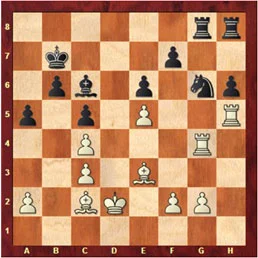Introduction
Magnus Carlsen’s achievements on the chessboard have led to many discussions about whether chess is something more than a board game. Among popular sports, some see chess as a science, while others appreciate the intellectual quality and excitement of a well-played game of chess. I think a more relevant question is whether one can learn anything from playing chess, or if it is just a pastime and for entertainment. A former world chess champion once stated that “chess is the art of analysis”, but I would add that it is also the art of making the best decisions, just as risk management is largely about facilitating good decisions. Through this article, I wish to show that chess is more than a simple board game and that we also have something to learn about risk management from chess.
How important is the chess game – risk appetite
Chess players often have varying risk appetites as seen through their difference in playing styles and willingness to attack. Magnus Carlsen has a unique style of finding the best moves and playing with low risk. He rarely makes moves that are not the best by assuming or underestimating that his opponent will not find the best counter-moves. At the same time, risk appetite can sometimes change due to changed assumptions or changes in one’s objectives. An amateur chess player once noticed that his risk appetite changed during a chess game in a team match. This game was the only one left, and the team was down 2-1 which meant that the player had to win it for the team to get a half match point. The opponent had over 200 rating points than him, and the amateur chess player had decided in advance not to take too many risks. But with the results on the other tables, he felt compelled to play with a higher risk. He had the possibility of a draw but chose to play for a win and lost a few moves later.
In a business, risk appetite defines how much risk it is willing to take to achieve its goals. A business may decide to establish itself in countries with weak governance due to previous experiences and with the belief that it can deal with corruption in an appropriate way. On the other hand, businesses with a low-risk appetite and little belief that they can handle challenges related to corruption will not take the risk of establishing themselves in the same countries.
Find the best moves – analyze and assess risk
When we teach chess to children, one of the first things we tell them is to sit down quietly and look at the board several times before making a move. Children are usually very eager and sometimes they race to make the fastest move. This often means that pieces are moved directly into play without careful consideration of possible counter-moves, or risks associated with them. Most times than not a checkmate occurs after a few moves. Most times than not a checkmate occurs after a few moves. In a similar way, risk analysis without sufficient depth, consideration of the effects of change, and /or holistic view of how incidents or changes can affect the whole business can quickly lead to wrong decisions being made (1).
In order to carry out good risk analyses, there are various methods that can be used. Risk methods should be adapted to the type of risk to be analyzed and assessed. One way to categorize risks that require different approaches is to divide them into controllable (or tactical) risks, strategic risks and external risks (2).
A small tow can topple a big load – controllable risks

In Magnus Carlsen’s WC match against Anand in Sochi 2014, a decisive moment occurred in the 6th game. The match was at that point 2.5 – 2.5 and a victory for one of the two would tilt the match in a decisive direction. After Magnus’s 26th move, the following situation arose; Magnus, as white, has just played the king to d2. This was a big mistake, which Magnus realized immediately after his move. Anand, on the other hand, did not see that it was a mistake, played a4, lost the whole game and later the whole match (if you know what Anand should have played in the diagram, you can send the answer to [email protected]). Controllable risks are risks that should often be minimized or eliminated. In general, there is no gain from taking these risks. Internal audits usually focus on these risks as unwanted incidents that may occur in various processes and check whether there are sufficient control measures in place. If risk management focuses on these risks or uses the same procedure for all types of risks, it will be challenging to manage the most important risks; the strategic ones.
The goal is to checkmate – strategic risk
Although the controllable risks can have a significant effect on the business (ref. Magnus’ blunder in the party against Anand), it is usually the strategic risks that are the most important ones for businesses. Several surveys show that the strategic risks are the ones that can be most significant for businesses (3).
For beginners in chess, it is mostly about learning to think two or three moves ahead and to avoid losing material (or pieces). The better you get, the less time you need to spend avoiding typical losing moves. The focus is shifted to the long-term plans that will form the basis for the final goal of checkmate. In the long-term plans, it is important to set interim goals, such as getting a knight to a central field on the board. In order to implement the plan, risks must be constantly assessed, such as e.g., whether it is necessary to make a move to stop the opponent’s plan. In the same way, businesses should assess risk against strategic objectives. After all, risk management is about managing uncertainty related to goal attainment. When businesses report on target achievement for the current quarter, it should also contain information on how likely it is that the long-term strategic targets will be achieved, and which uncertainties (risks) affect target achievement.
The surrounding framework – external risk
External risks can be divided into different types; natural disasters or economic shocks with immediate effect, e.g., volcanic eruptions in Iceland; geopolitical or environmental changes with long-term effects such as global warming; and changes in the competitive situation such Netflix or Uber’s disruptions of markets. Some of the techniques for analyzing risks, especially external ones, can be stress testing and scenario analyses. Scenario analysis was developed around World War II by Alan Turing who played chess with his colleagues during breaks and harbored the idea of creating a chess machine (4). He realized that it would be useless to program the computer to calculate all the possible chess moves. Instead, Turing’s plan was to make the machine learn from its previous games, an idea that was realized many years after Turing’s death through Monte Carlo simulations where the computer in a few seconds plays hundreds of thousands of games against itself from a relevant position before choosing the move that gives the best statistical payoff. Used in the right way, Monte Carlo simulations are a simple and quick aid to increase a business’s understanding of risk.
A chess program can easily provide advice on moves that are not easy for humans to detect, and with constantly new technical aids it is difficult to prevent those who want to cheat in chess. One of the biggest scandals in chess was when the French national team was caught cheating in the 2010 Chess Olympics (yes, there are separate Olympics for chess). One of the French chess players was helped by an assistant who sat at home and followed the game directly over the internet and analyzed it. He sent a coded SMS to the team manager such as “63-68” as part of a phone number. The team leader then found his place in the Olympic Hall where he went to table number 63 and then to table number 68. The chess player interpreted this as move piece on f3 to f8. The French chess player won most of the games and was also awarded a cash prize of 5,000 Euros. The cheating was discovered by the Vice-president of the French Chess Federation, who received an erroneously sent text message from the team leader saying, “hurry up, send more moves”.
Conclusion
The best and the most effective way to improve in chess is to analyze the game afterward, preferably together with the opponent or together with a coach. In this evaluation, it is important to gain an understanding of the decisions that were made. Questions a coach can ask to gain this understanding are whether adequate analysis was carried out, whether were there any overlooked moves, and what was the long-term, strategic plan. Like a chess coach who gives advice on how a chess player can improve his game, businesses should also have functions that fulfill a similar coaching role of asking questions about the basis for major and minor decisions. Chess is a game where the situation changes with each move; tactical risks arise, and strategic plans are changed. This requires the chess player to do sufficient risk analysis before a decision on a move is made. In the same way, businesses can learn how good risk analyses contribute to better decisions being made. For my own part, I like to play chess for entertainment and excitement, but I also encourage others to play chess to improve risk management.
Note: This article was first published in Norwegian in the IIA Norway magazine SIRK in 2017.

